Crew 56 – Assigned 754th Squadron – October 1943
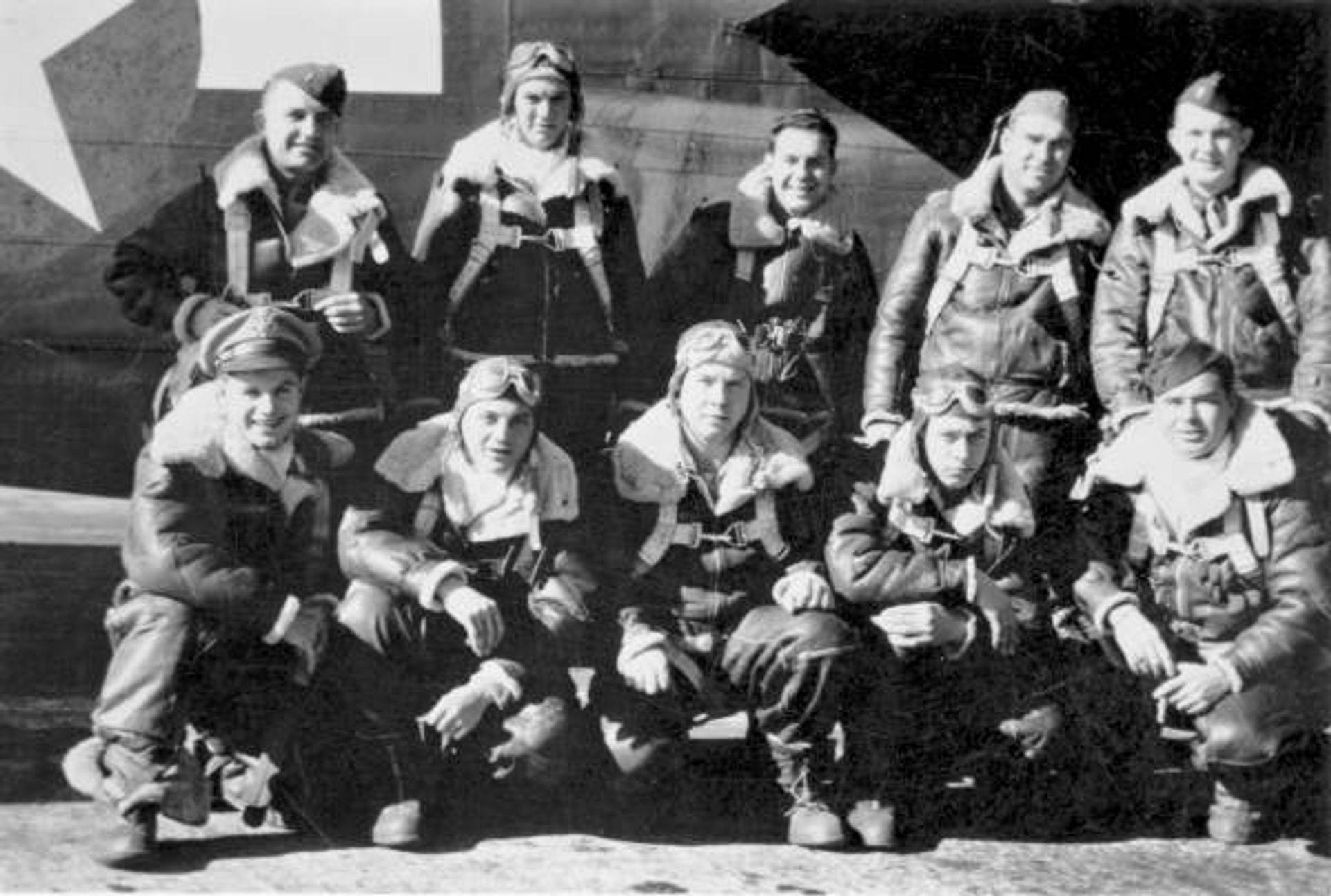
Shot down April 9, 1944 – MACR 3836
| Rank | Name | Serial # | Pos | Date | Status | Comments |
|---|---|---|---|---|---|---|
| 1Lt | Walter J Raiter | 0747488 | Pilot | 09-Apr-44 | EVD/POW | Stalag Luft I |
| 2Lt | Arthur L Goodin | 0693770 | Co-pilot | 09-Apr-44 | POW | Stalag Luft I |
| 2Lt | Harry Stawiarski | 0694899 | Navigator | 09-Apr-44 | KIA | Cuyahoga County, OH |
| 2Lt | Richard Koch | 0752815 | Bombardier | 09-Apr-44 | POW | Stalag Luft I |
| S/Sgt | James A Goins | 35693781 | Radio Operator | 09-Apr-44 | POW | Stalag 17B |
| T/Sgt | William P Howard | 38282754 | Flight Engineer | 09-Apr-44 | POW | Stalag 17B |
| S/Sgt | Allen R Kluck | 17078898 | Ball Turret Gunner | 09-Apr-44 | KIA | Colfax County, NE |
| S/Sgt | Angelo J Pucci | 33586841 | Waist Gunner | 09-Apr-44 | POW | Stalag 17B |
| S/Sgt | Doris H Cornette | 14165511 | Waist Gunner | 09-Apr-44 | POW | Stalag 17B |
| S/Sgt | Harry S Raughley | 32751782 | Tail Turret Gunner | 09-Apr-44 | KIA | Kent County, DE |
Crew 56 trained in Tonopah with the 458th and flew the Southern Route to the ETO in January 1944.
On April 9, 1944, Easter Sunday, the 458th Bomb Group was assigned to fly a mission to Tutow, Germany. The group formed well, but met heavy clouds just before reaching the Danish coast. The group at first tried to gain altitude so as to fly above the clouds, but it was soon clear that they would not make it. The pilots were ordered to spread out and maintain a course of 90° and to hold that while flying through the clouds. As soon as the group broke through on the other side some of the B-24’s were attacked by German fighters before they could regain formation.
Crew #56 was flying their B24H-10-DT 41-29295 Z5 K Bomb Totin’ Mama off of the left wing of Captain Valin R. Woodward (Crew 41) who was flying in the second element that day. Soon after the formation reached the Initial Point and the fighter attacks began, Raiter’s plane was hit while they were still over Kiel Bay. Woodward saw part of the attacks on Raiter and reported the following upon his return to base, “Raiter is believed to have been hit by attacking E/A over Kiel Bay at 1110. He dropped out of formation with an engine on fire. For a while he flew along about 5000 feet below the formation. In the vicinity of Gedser Head, Denmark…he was seen heading NNE with two enemy fighters following him. The A/C was under control when last sighted.”
FW190’s had knocked out the number three engine and it was feathered. Number two was also hit, but continued to operate although it was leaking oil. The intercom was also knocked out in the initial attack, but at this point the crew were all uninjured. The decision was made to stay with the formation, but before they reached the German coast number two engine started smoking and had to be feathered. The crew had no choice but to turn west for England. In a statement made after being released from Stalag Luft I, Walt Raiter recalled the attack, “We were attacked at the I.P. ten miles or so out in the Baltic Sea. After being seriously damaged and forced to leave the formation, we were under constant attack until reaching a point approximately fifty miles southeast of Hamburg. At that time we ran out of ammo and the tail gunner was killed and one of the enemy planes lined up on the center row of rivets and did all the damage. I believe, although I have no proof, that all three men were killed in that one pass. We had lost all inter-communications an hour before so most of this I pieced together from my other crew members and what I know.”
Raiter sent the radio operator, S/Sgt James A. Goins, back to the waist to tell the men there to be ready to bail out upon a pre-arranged signal. S/Sgt D. Hulon Cornette from High Pointe, North Carolina was the waist gunner and the assistant engineer on Bomb Totin’ Mama. He and nose turret gunner S/Sgt Allen R. Kluck of Richland, Nebraska were roommates and best friends.
After his release from Stalag 17B in 1945, Cornette wrote to Allen Kluck’s wife:“Easter Sunday, April 9, 1944 was the day it all happened. We were on the way to a target in Northern Germany. We ran into fighters out in the Baltic just before turning in over land. They knocked number three engine to pieces and put a hole in an oil line in number two which kept running until we hit the German coast. My pilot then had to feather that engine. That left us going on two engines. We…flew perhaps an hour and a half when the pilot sent the radio operator back to the waist where my gun position was and said we were not going to make it back to England and for us to get ready to bail out when he dipped the plane. The interphone had been shot out and we couldn’t talk to each other over it. Everybody knew we were going to bail out within the next few minutes and everyone was all right then. Allen was in the nose turret and I was in the waist so I can’t tell you what went on up there. We had put our ‘chutes on and opened the hatch to bail out when I saw two fighters coming in on our tail and I started firing at them. The first fighter was shot down, but the second got us bad. The tail gunner[S/Sgt Harold S. Raughley]had taken off his ‘chute and gotten back into his turret when he saw me firing at the planes. I do know that he was killed by a direct burst. In the waist, fire was everywhere and the right wing was flaming. Lieutenant Koch[the bombardier, who was manning the other waist gun]told me to bail out, so I hit the silk. On the way down I counted six ‘chutes. The plane did not immediately go down. It went into a shallow dive so that everybody that was alive had a good chance to get out. I was captured immediately upon hitting the ground. All six of us were caught right away. They were down there waiting on us. When I said I saw six ‘chutes, that is right. I didn’t know my pilot, Lieutenant Raiter, had gotten out. He stayed in the plane, trying to hold her level and give us a good chance to get out. An explosion in the cockpit blew him out a few thousand feet before the plane hit the ground. I found this out from him after he was captured a few days later in a temporary camp in Germany. None of the crew saw Lieutenant Raiter’s ‘chute and we were surprised to see him brought into prison. I kept looking to see Allen and Lieutenant Stawiarski brought into camp, but I never did see them.”
Walt Raiter evaded capture for several days, but was eventually captured and sent to Stalag Luft I near Barth.
Translated from a captured German document
On 12 April 1944 1st. Lt. Apenbring made a telephone call from Hollenstadt/Luensburg to Unit and reported that in the gasthuas Hoppe (Hollenstadt) an American [Raiter] out of an American plane is captured and asked for further transportation. 1st Lt. Apenbring declared that the American was hiding in the vicinity for several days and probably made an escape. After that, the American was taken by the Unit and was transferred to Heidenau. One night he was located in a jail cell and was transferred on 13 April 1944 to POW camp Dulag Luft Oberusel/Main.
Missions
| Date | Target | 458th Msn | Pilot Msn | Serial | RCL | Sqdn | A/C Msn | A/C Name | Comments |
|---|---|---|---|---|---|---|---|---|---|
| 24-Feb-44 | DUTCH COAST | D1 | -- | 42-52515 | -- | Z5 | D1 | FORD'S FOLLY | Diversion Mission |
| 02-Mar-44 | FRANKFURT | 1 | 1 | 42-52353 | J | Z5 | 1 | UNKNOWN 049 | |
| 03-Mar-44 | BERLIN | 2 | 2 | 42-100366 | -- | Z5 | 2 | MIZPAH | |
| 05-Mar-44 | BORDEAUX/MERIGNAC | 3 | 3 | 42-52450 | G | Z5 | 2 | UNKNOWN 032 | |
| 08-Mar-44 | BERLIN/ERKNER | 5 | 4 | 41-28682 | I | Z5 | 5 | UNKNOWN 003 | |
| 15-Mar-44 | BRUNSWICK | 7 | 5 | 41-29305 | N | Z5 | 2 | I'LL BE BACK/HYPOCHONDRIAC | |
| 16-Mar-44 | FRIEDRICHSHAFEN | 8 | 6 | 41-29295 | K | Z5 | 1 | BOMB TOTIN' MAMA | |
| 21-Mar-44 | WATTEN | 10 | 7 | 41-29295 | K | Z5 | 2 | BOMB TOTIN' MAMA | |
| 22-Mar-44 | BERLIN | 11 | 8 | 41-29295 | K | Z5 | 3 | BOMB TOTIN' MAMA | |
| 24-Mar-44 | ST. DIZIER | 13 | 9 | 41-29295 | K | Z5 | 5 | BOMB TOTIN' MAMA | |
| 26-Mar-44 | BONNIERES | 14 | 10 | 41-29295 | K | Z5 | 6 | BOMB TOTIN' MAMA | |
| 27-Mar-44 | BIARRITZ | 15 | 11 | 41-29295 | Z5 | 7 | BOMB TOTIN' MAMA | ||
| 09-Apr-44 | TUTOW A/F | 18 | 12 | 41-29295 | K | Z5 | 10 | BOMB TOTIN' MAMA | FTR - FIGHTERS |
Lt Walter Raiter’s Wedding photo
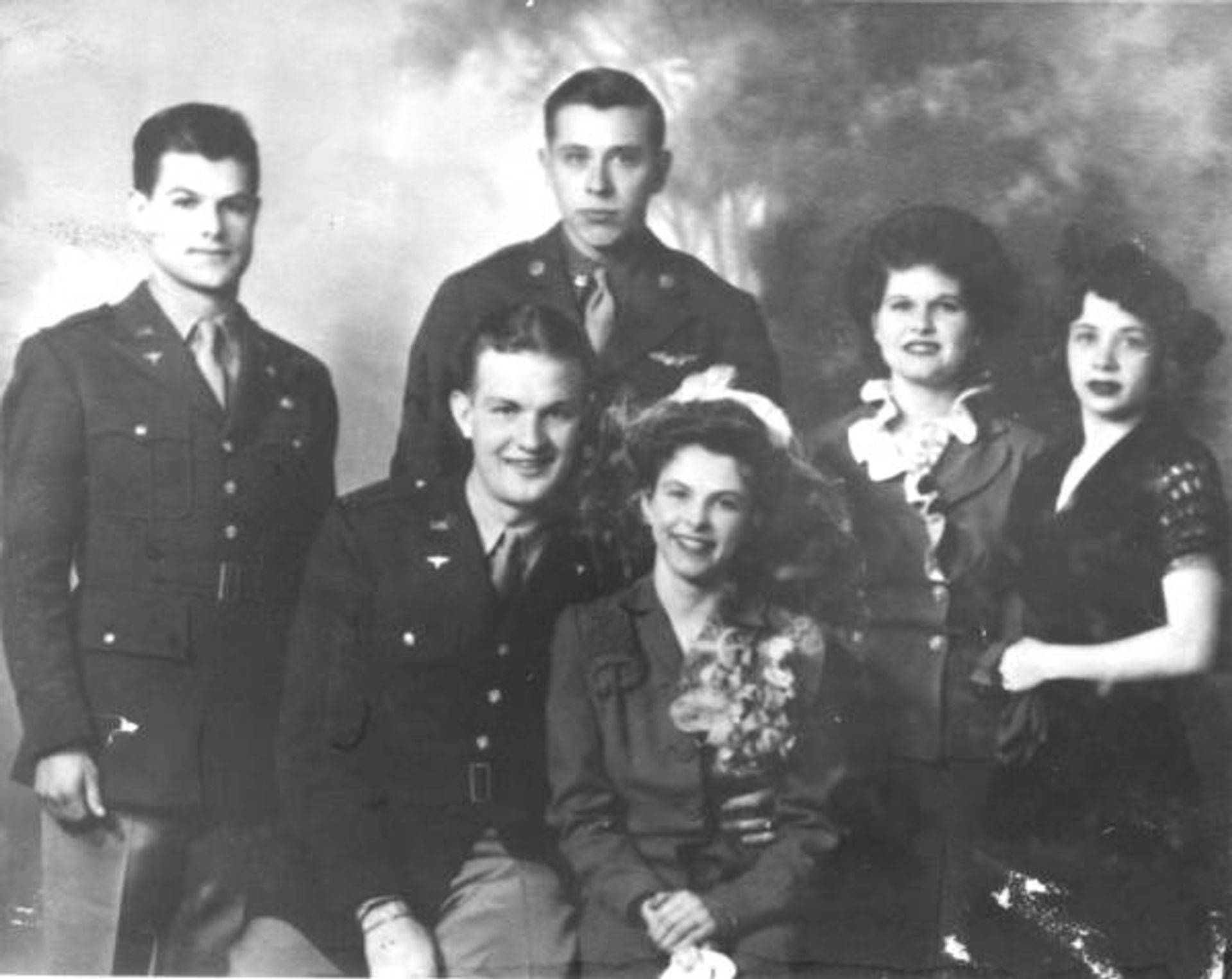
Richard Koch and D. Hulon Cornette along with their wives, Jean Koch and Jessie Cornette,
served as the wedding party to Walt and Shirley Raiter
Photo: Hulon Cornette
S/Sgt James A Goins
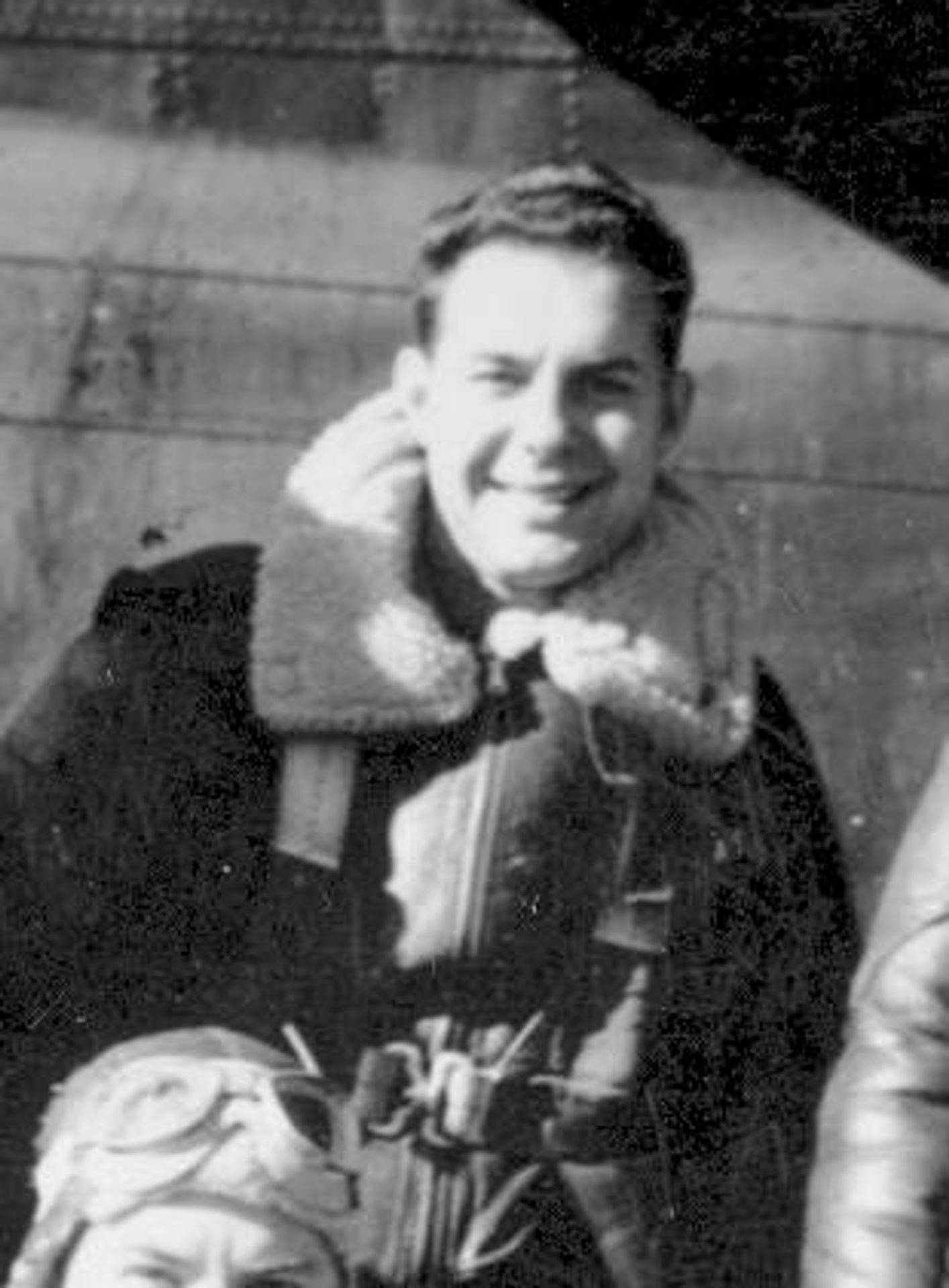
The personal journal of James A. Goins
From – Mar. 6, 1944 To –
Combat Missions in the U.K. 8th Air Force
Before commencing my combat missions in Britain, I was engaged in Schooling – mostly communications. I also, however, was given lectures by very competent instructors concerning such subjects as oxygen, hygiene, Prisoner of War Intelligence, gunnery, Distress Procedures, and other such important topics.
Before we were deemed actually fully prepared to meet opposition, we had to undergo a few practice training missions within the boundaries of England, itself. They were exactly as they were in the States – very inefficient – but helpful so far as the Navigation and Radio facilities of the Island were concerned. At least we became acquainted with most of what England had to offer. It was very necessary to study minutely the entire set up, inasmuch as the E.T.O. out of England was to be our Operational Territory for a period of time. Immediately following our period of practice we were called upon for diversionary missions – two of which were seen through to their entirety. One of them was aborted because our formation could not be found. We also had, as good alibis, however, the facts that the nose turret door had blown off and that in its …flight over the ship, it had taken with it my liaison [?] antenna.
Our first actual combat mission was made on the day of Mar. 2, 1944. Our target as planned and outlined to us at briefing, was supposed to have been a factory, essential to Germany’s War effort, within the city of Frankfurt, Germany. The mission was flown without mishap to any of our planes altho’ flak was seen at intervals throughout France and Germany. Our first glimpse of flak was beheld not long after flying across the French coast. It, however, was sporadic and very inaccurate. Possibly its main objectives were the supposed deterrent effect upon our planes and the ensuing boost for the morale of the German people. As we came closer to our target the flak was much heavier – sometimes seen in clouds – but it was still inaccurate, and its major purpose in that instance, was thwarted by all our planes returning safely with nothing more than a few flak holes to indicate the little ordeal through which we had passed. The ship in which I was flying had not a scratch upon it. The 458th Group missed the target completely upon this mission. We bombed by P.F.F. and the Pathfinder ship was the blame. The formation flying led by Col. Isbell, was very good. The high right element in which I was flying was praised by the 14th Wing and the General of this field. I watched the bombing from the bombay, since I had taken that position to stop possible c—page [illegible to me, definitely begins with “c” and ends with “page”] of the Bombay doors. The bombs from my ship and from those in the immediate vicinity, fell upon a barren spot. I learned later, however, that a small village directly south of us and a factory had been entirely demolished by our group. (One plane cracked – up on the runway before takeoff)
Mar. 4, 1944
Our second mission was completed Mar. 4, 1944. Our target on this mission was to have been a factory in a city some 16 miles from Berlin. None of the Group reached the objective. My own plane aborted about 5 minutes before we reached the coast of France. The extreme cold was one of the reasons, all of our guns froze. Another reason which we gave was that two of our superchargers were out. The ensuing lagging in the formation would have been a direct invitation to enemy fighters. We did see some enemy fighters that day. On our solitary return to Britain, some of us, realizing our perilous condition, became a little excited. One yellow-nosed enemy plane and a few other “probables” were reported as having been seen. We, however, reached our base with no trouble and with the aid of a bearing which I had secured for the Navigator. I was to discover when I landed, that most of the formation had also aborted. Part of the Group came as close as one hundred miles to their objective, but were recalled because of bad weather. Most planes dropped their bombs at any available spot. Our own were dropped in the Channel. I believe, that one plane from another Squadron was lost that day.
March 5, 1944
My third raid was completed on the above date. Our objective for that date was a runway and hangars of an airfield in Bordeaux, France. The formation flying on that day was so poor that most of our group seemed, somehow, to have found their way into other groups. My ship flew for a short time with another group before finding our group. We finished the mission with our group. The 458th group did not find the target, and we seemed to fly around in circles for some time, giving the enemy every chance to attack and train their anti-aircraft. The planes who flew in with other groups reported that the target was entirely demolished. Some of our group dropped bombs upon another airfield, but little damage was done. Before we began searching for the target, we discovered that our fuel was low. During the entire nerve wracking [difficult to determine the correct transcription of these handwritten words, could be “never reaching”] time of circling, we were worried about our chance of survival. After leaving our target area, which was heavily guarded by flak, we started back to England. Before we left France, our fuel was so low that I contacted a low Freq. station and began S.O.S. procedure. I was fixed by the station throughout the entire return trip to Britain. Many of the planes ran low on fuel during the mission. I, myself, noticed that I was in the Bombay for a considerable length of time. We later discovered that a piece of flak had punctured the ship in the left forward Bombay during the time in the target area. During the return to England, everything was done for ditching. We didn’t expect to reach friendly coasts at all. Another plane flew at a distance behind us, and their navigator used our fixes which I was securing. Both planes landed at a small British field some_ _ [(?) indiscernible, possibly corrected by the following word] somewhere in England. After refueling we returned to our base. We had been given up for lost and everyone seemed overjoyed at our safe return.
Mar. 6
Another mission in which we did not participate came about today. Many planes from many fields – including B-17’s – were used. The target was in Berlin. Ten ships in our Group have been reported missing as I am writing this. Three ships were lost from our Squadron. As yet no news has reached the base about them. The crew who live upstairs in my apartment, whose R.O.’s name is [Sgt. Leroy] Smith, Lt. [Thayer] Hopkin’s crew (R.O. Peterson) and Lt. Ballard’s crew (R.O. Nemeth) are the crews reported as missing.[R.O., Sgt. L. Smith was listed as KIA – Berlin. 2nd Lt. T. Hopkins evaded capture ‘til 9/26/45 with assistance of the Dutch Underground, and his R.O., Sgt. J. Peterson was a POW @ L.S. – III, according to the 458th’s “Combat Crews” website section. Lt. B. Ballard was a POW of L.S. – I, and his R.O., Sgt. J. Nemeth was listed as KIA – Margraten] One ship from another Squadron (Lt. Brudos)* exploded over the target. Some report that two chutes left it. One tail gunner in this Squadron was wounded in the leg by a 20mm shell and possible amputation may develop. Two or three passes were made at the target and altho’ it was completely destroyed [this account of Lt. Brudos’ crew is contradicted in the “Combat Crews” section, but it could have been McMains’ ship of the 752nd Sq., whose story relates.](as was factory) the enemy had all the needed time to take action. Many fighters were seen by the crews. Flak, too – was extremely heavy. To this date I am accredited with two missions and two sorties or two and one half missions – since four sorties compose a mission. Another mission is scheduled for tomorrow. My Pilot was given the opportunity to fly the Deputy Lead ship, but I do not believe he will take it since such a step will necessitate the removal of our own Navigator and Bombardier from our crew with subsequent replacement with Squadron men of high rank. I personally would not like the change, but surely Lt. Raiter deserves it. My own position too would be more important, but I know that none of us could work as well as usual with the change in officers. I have had little experience with the replacements for our crew, and I know that I would not be desirous of flying with them for long.
Mar. 7, 1944
To this date, the three crews from my Squadron (754) have not been located. It is probable that some, if not all of them bailed out in France. At least, we have left to us the hope that they are alive. I sincerely believe that they are, altho’ I can see that the probability of their being Prisoners of War is strong. The number of ships lost from this Group has finally been fixed as five. Already the Squadron is beginning to pack the belongings of the missing crews – ready for the shipment to the States. A mission was scheduled for today and the target would have been in Germany. It was, however, scrubbed during the Enlisted Men’s General Briefing.
Mar. 8, 1944
I am writing this account on the day of the 19th, therefore details of our mission of the 8th are not absolutely clear in my mind. Our target on the 8th was a ball bearing factory near Berlin. The factory was a very essential one since it produced one-half of ball bearings for Germany’s war effort. As I remember it, blind bombing was done and reports say that the target was hit so badly that it cannot operate again. No great amount of damage was done to the plane in which we were flying that day. The mission, on a whole was an easy one.
Mar. 15, 1944
After resting a bit because of bad weather, especially very strong winds, we undertook our next mission. Our target was supposed to have been a [crossed out lines read, “seaplane base” at “Friedrichshafen” corrected with] factory at Brunswick, Germany.] [Crossed out as well, followed the line… “Friedrichshafen is located in Southern Germany just North of Switzerland”] Our plane only reached within 12 miles of Germany. Our trouble was in number 1 and number 4 engines. That day we did something which had never before been done in the E.T.O. _ i.e._ we brought a B-24 Back from Germany on two engines – alone and unprotected. Only a miracle is the answer because, especially using only the two inboard engines, such a feat was deemed almost [Crossed through, illegible word – maybe “unequal” or corrected for spacing to the following…] impossible. We were at 20,000 feet when the trouble began. We flew most of the way at 6000 feet with a speed of 130 M.P.h. We seemed to be just mushing along and everyone was slightly worried. We encountered neither flak nor fighters, however, on our return to the field. I began sending S.O.S.’s before we left France and was fixed until we reached the coast of England. I had no trouble using my distress procedure and I tried to relate my station as much information as possible. We managed to land at our base amid surprise and wonder both to ourselves and the Group and Operations officers.
Mar. 16, 1944
Upon the above date a raid was undertaken to the Friedrichshafen, Germany, just North of Switzerland. Our target was a seaplane base and reports say that it was very badly hit, altho’ many bombs fell into a nearby lake. Fighters were seen along the route – including a P-47 with a yellow-nose and a swastika painted upon it. No damage, however, was done by them. We were flying our own plane – “Bomb Totin’ Mama” on that raid. Everything was perfect and it seemed as if [written above the word “that”] this was [looks like “were”, but changed by the previous alteration] going to be our easiest raid. We reached the target and bombed it with no trouble from flak. On our return from the target, we ran into the heaviest flak that this group has yet seen. We could hear it bursting all around us. Our lead ship used no aversion, so we just flew through it. We lost number three engine when we hit the second barrage of flak. A piece of flak also hit the nose turret at the same time. During the rest of our return journey we flew on three engines and experienced no other difficulty. We landed at a field near our base, because our hydraulic system had burnt out in the air and for other reasons. When we examined our ship we discovered that it had been hit by flak a great number of times. One piece of flak had gone into the ship directly below the R.O. and First Engines. Another piece had gone in at the side of the Radio Operator. Of course holes were found over the entire fuselage, but no great damage was done to the plane.
Mar. 19, 1944
To this day I am accredited with 5 missions and two sorties. I am on a 48-hour pass now. I have not attempted to narrate raids made by the group in which I did not participate, but such raids were made.
——————————————————-
This concludes the handwritten accounts made by my Great-Uncle S/Sgt. James A. Goins in his notebook. My comments are in [italics].
[Identified in a handwritten note on the back of an original, Crew photo from Tonopah, Nevada, as Cpl. James A. Goins_ R.O. M. Gunner & dated Dec. 25, 194? (photo cut at top border eliminating last digit, maybe 1942? His change of address form is type-dated 9 December 1943 from Tonopah Army Air Field to APO 9378. However, the postmark is dated Jan. 12, 1944 – 1 PM)].
His plane and fellow crew were downed on Easter Sunday April 9th, 1944. Three of the crew were killed, the others were captured and held as POW’s.
Sometime after 11/11/44 – the last dated postcard he sent home from his original internment camp, L.S. III – [The other being dated 5/25/44, some 47 days after his being shot down.] he was transferred to Luft Stalag XVIIB, from which two cards dated 1/26 & 28/45 were posted. His “Gefangenennummer” being listed on all four cards as,106353.
As noted in another small notebook in which he kept abbreviated notes at the time, he and fellow prisoners of that camp were marched “thru’ Austria from Krems (About 210 Kilos.)” around April 8, 1945 and liberated May 3rd 1945, “11Kilos from Braunau…No longer prisoner of War, German Col. surrendered to American Cpt.”
Very kindly submitted by James Goins great-nephew: Chris Casey
B24H-10-DT 41-29295 Z5 K Bomb Totin’ Mama
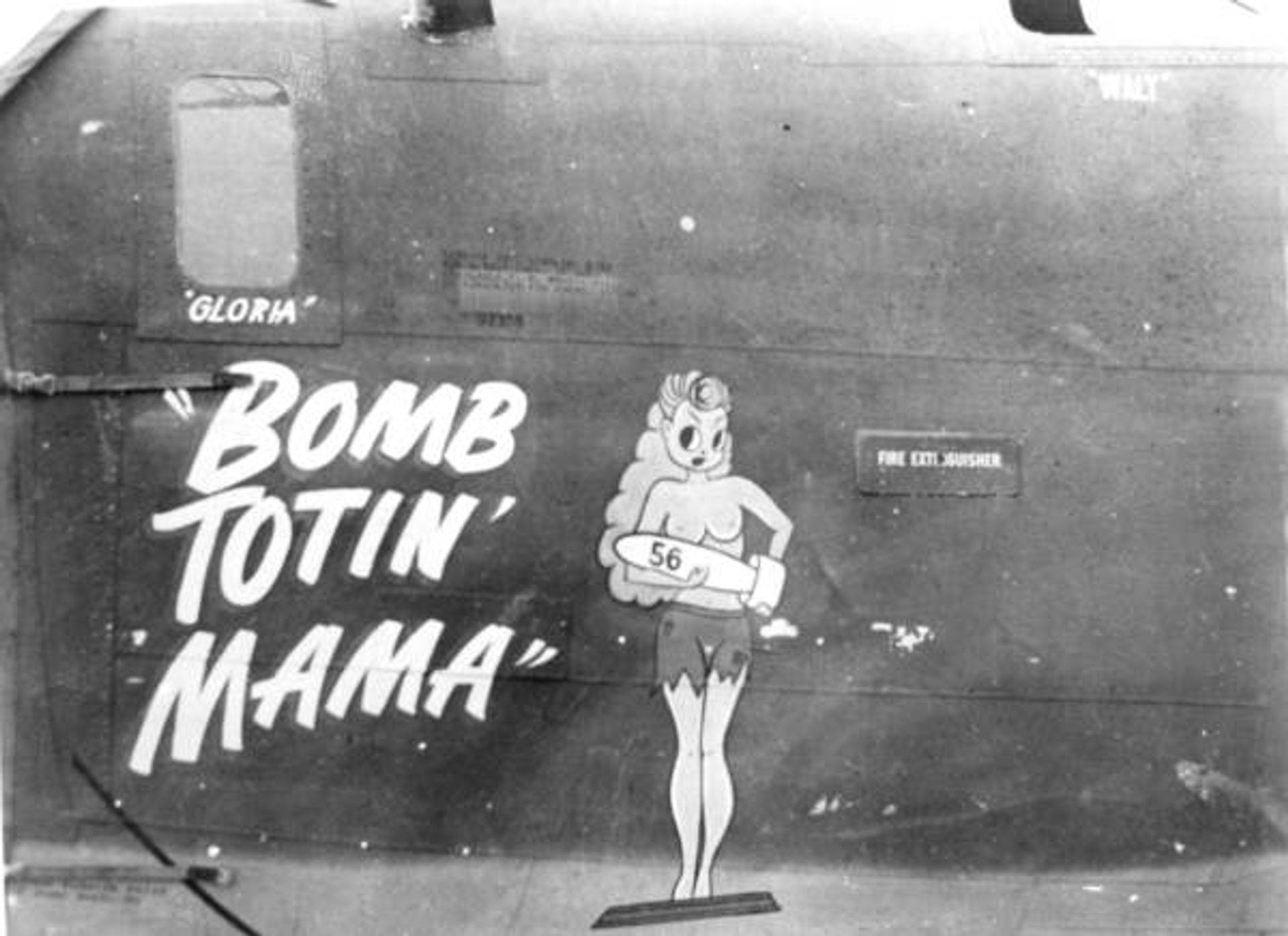

Courtesy: Anthony Gaster
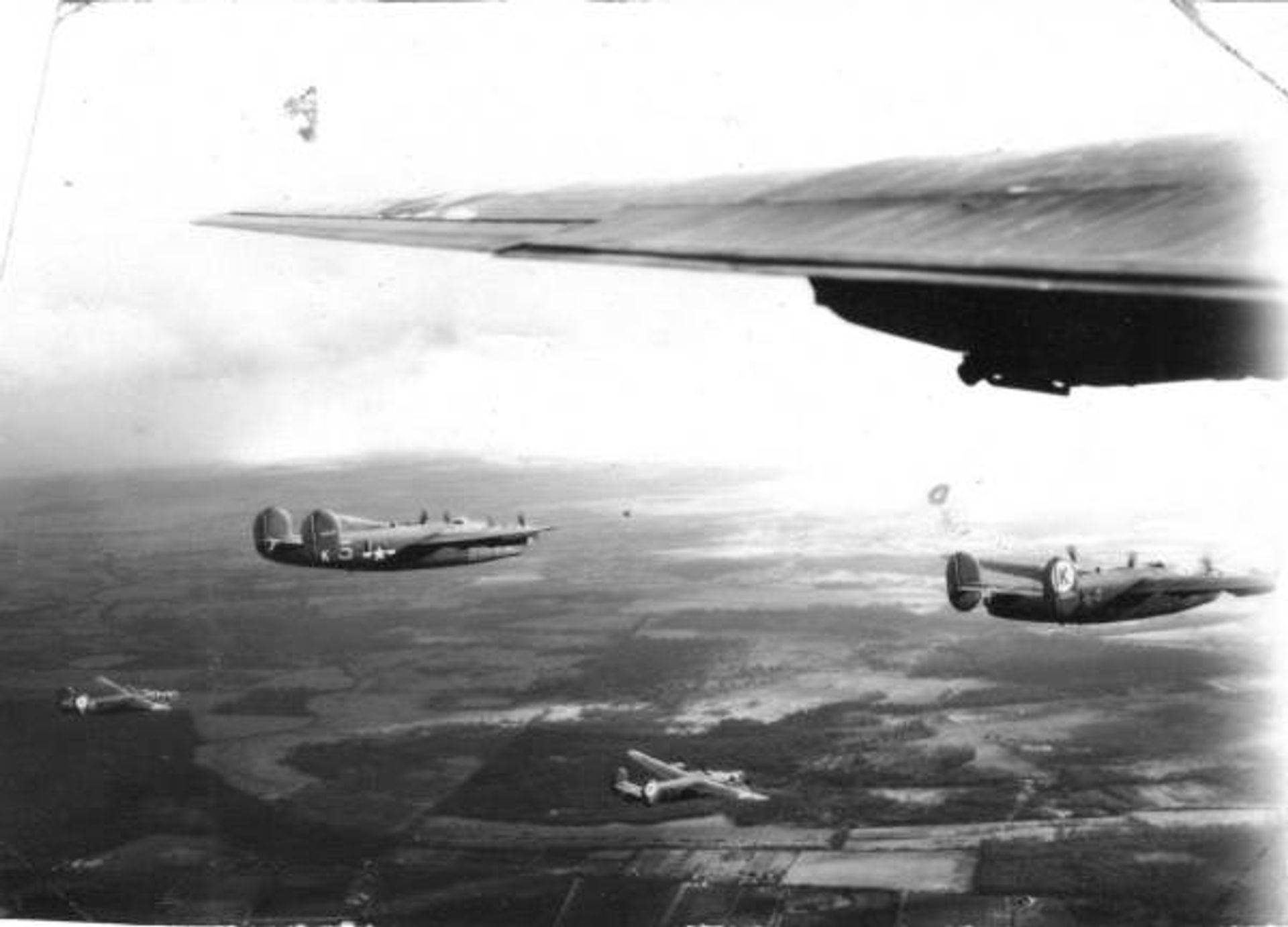
Shown center left without group insignia on tail, but RCL “K” is clearly visible. Most likely taken in February or March 1944.
